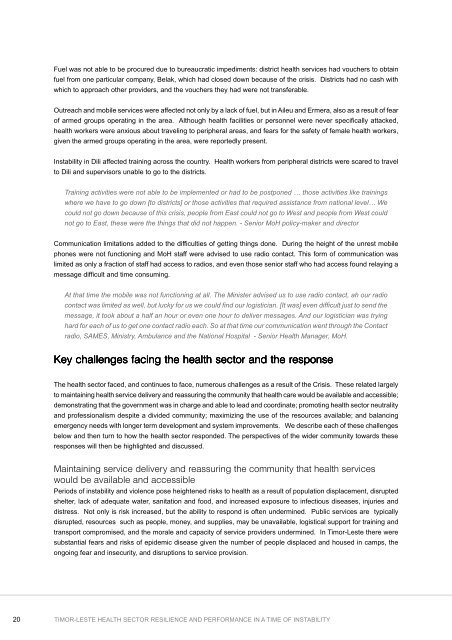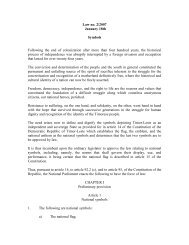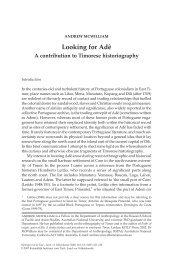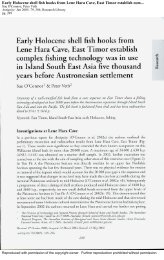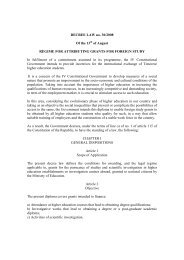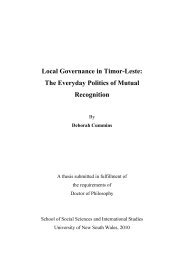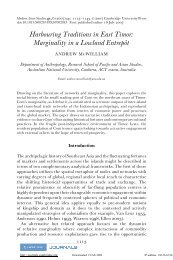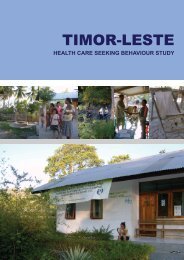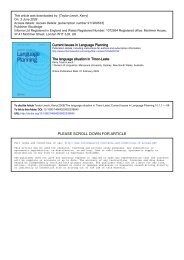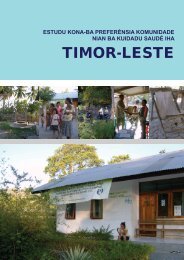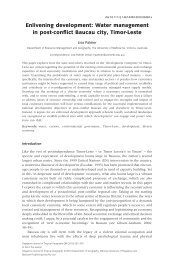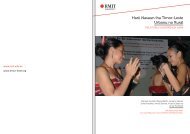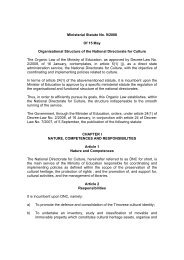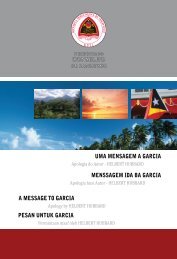Timor-Leste. Health Sector Resilience and Performance in a Time of ...
Timor-Leste. Health Sector Resilience and Performance in a Time of ...
Timor-Leste. Health Sector Resilience and Performance in a Time of ...
- No tags were found...
You also want an ePaper? Increase the reach of your titles
YUMPU automatically turns print PDFs into web optimized ePapers that Google loves.
Fuel was not able to be procured due to bureaucratic impediments: district health services had vouchers to obta<strong>in</strong>fuel from one particular company, Belak, which had closed down because <strong>of</strong> the crisis. Districts had no cash withwhich to approach other providers, <strong>and</strong> the vouchers they had were not transferable.Outreach <strong>and</strong> mobile services were affected not only by a lack <strong>of</strong> fuel, but <strong>in</strong> Aileu <strong>and</strong> Ermera, also as a result <strong>of</strong> fear<strong>of</strong> armed groups operat<strong>in</strong>g <strong>in</strong> the area. Although health facilities or personnel were never specifically attacked,health workers were anxious about travel<strong>in</strong>g to peripheral areas, <strong>and</strong> fears for the safety <strong>of</strong> female health workers,given the armed groups operat<strong>in</strong>g <strong>in</strong> the area, were reportedly present.Instability <strong>in</strong> Dili affected tra<strong>in</strong><strong>in</strong>g across the country. <strong>Health</strong> workers from peripheral districts were scared to travelto Dili <strong>and</strong> supervisors unable to go to the districts.Tra<strong>in</strong><strong>in</strong>g activities were not able to be implemented or had to be postponed … those activities like tra<strong>in</strong><strong>in</strong>gswhere we have to go down [to districts] or those activities that required assistance from national level… Wecould not go down because <strong>of</strong> this crisis, people from East could not go to West <strong>and</strong> people from West couldnot go to East, these were the th<strong>in</strong>gs that did not happen. - Senior MoH policy-maker <strong>and</strong> directorCommunication limitations added to the difficulties <strong>of</strong> gett<strong>in</strong>g th<strong>in</strong>gs done. Dur<strong>in</strong>g the height <strong>of</strong> the unrest mobilephones were not function<strong>in</strong>g <strong>and</strong> MoH staff were advised to use radio contact. This form <strong>of</strong> communication waslimited as only a fraction <strong>of</strong> staff had access to radios, <strong>and</strong> even those senior staff who had access found relay<strong>in</strong>g amessage difficult <strong>and</strong> time consum<strong>in</strong>g.At that time the mobile was not function<strong>in</strong>g at all. The M<strong>in</strong>ister advised us to use radio contact, ah our radiocontact was limited as well, but lucky for us we could f<strong>in</strong>d our logistician. [It was] even difficult just to send themessage, it took about a half an hour or even one hour to deliver messages. And our logistician was try<strong>in</strong>ghard for each <strong>of</strong> us to get one contact radio each. So at that time our communication went through the Contactradio, SAMES, M<strong>in</strong>istry, Ambulance <strong>and</strong> the National Hospital - Senior <strong>Health</strong> Manager, MoH.Key challenges fac<strong>in</strong>g the health sector <strong>and</strong> the responseThe health sector faced, <strong>and</strong> cont<strong>in</strong>ues to face, numerous challenges as a result <strong>of</strong> the Crisis. These related largelyto ma<strong>in</strong>ta<strong>in</strong><strong>in</strong>g health service delivery <strong>and</strong> reassur<strong>in</strong>g the community that health care would be available <strong>and</strong> accessible;demonstrat<strong>in</strong>g that the government was <strong>in</strong> charge <strong>and</strong> able to lead <strong>and</strong> coord<strong>in</strong>ate; promot<strong>in</strong>g health sector neutrality<strong>and</strong> pr<strong>of</strong>essionalism despite a divided community; maximiz<strong>in</strong>g the use <strong>of</strong> the resources available; <strong>and</strong> balanc<strong>in</strong>gemergency needs with longer term development <strong>and</strong> system improvements. We describe each <strong>of</strong> these challengesbelow <strong>and</strong> then turn to how the health sector responded. The perspectives <strong>of</strong> the wider community towards theseresponses will then be highlighted <strong>and</strong> discussed.Ma<strong>in</strong>ta<strong>in</strong><strong>in</strong>g service delivery <strong>and</strong> reassur<strong>in</strong>g the community that health serviceswould be available <strong>and</strong> accessiblePeriods <strong>of</strong> <strong>in</strong>stability <strong>and</strong> violence pose heightened risks to health as a result <strong>of</strong> population displacement, disruptedshelter, lack <strong>of</strong> adequate water, sanitation <strong>and</strong> food, <strong>and</strong> <strong>in</strong>creased exposure to <strong>in</strong>fectious diseases, <strong>in</strong>juries <strong>and</strong>distress. Not only is risk <strong>in</strong>creased, but the ability to respond is <strong>of</strong>ten underm<strong>in</strong>ed. Public services are typicallydisrupted, resources such as people, money, <strong>and</strong> supplies, may be unavailable, logistical support for tra<strong>in</strong><strong>in</strong>g <strong>and</strong>transport compromised, <strong>and</strong> the morale <strong>and</strong> capacity <strong>of</strong> service providers underm<strong>in</strong>ed. In <strong>Timor</strong>-<strong>Leste</strong> there weresubstantial fears <strong>and</strong> risks <strong>of</strong> epidemic disease given the number <strong>of</strong> people displaced <strong>and</strong> housed <strong>in</strong> camps, theongo<strong>in</strong>g fear <strong>and</strong> <strong>in</strong>security, <strong>and</strong> disruptions to service provision.20 TIMOR-LESTE HEALTH SECTOR RESILIENCE AND PERFORMANCE IN A TIME OF INSTABILITY


